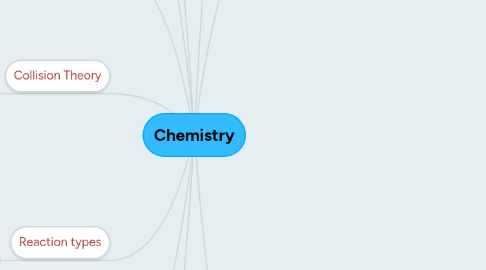
1. Bohr Models
1.1. shows the way an element is structured
1.2. easy way to have drawn model of element
2. Types of Radiation
2.1. Gamma
2.1.1. strongest type of radiaton
2.1.2. transmutation does not occur during decay
2.2. Beta
2.2.1. stronger than alpha
2.2.2. transmutation occurs during decay
2.3. Alpha
2.3.1. weakest type of radiaton
2.3.2. transmutation occurs during decay
3. Half life
3.1. the average length of time for half of the parent nuclei in a sample to decay
4. Nuclear Reactions
4.1. Fission
4.1.1. large nucleus is split into two smaller nuclei
4.1.2. total mass of the products produced is smaller than the original mass
4.2. Fussion
4.2.1. two small nuclei are joined into one nucleus
5. Collision Theory
5.1. for a reaction to occur molecules need to be moving and collide to react
5.2. factors that affect reaction rates;
5.2.1. concentration of reactants
5.2.2. surface area of reactants
5.2.3. temperature
5.2.4. catalysts
6. Reaction types
6.1. synthesis
6.1.1. two or more reactants form a compound
6.2. decompisition
6.2.1. a compound breaks into two or more products
6.3. single replacement
6.3.1. in a compound replace one element with a other one added as a reactant
6.4. double replacement
6.4.1. elements form compounds swap to form new compounds
6.5. combustion
6.5.1. a compound or element reacts with oxygen to create oxide and release energy
7. Law of Concervation of mass
7.1. mater is not created or lost in a chemical reaction
7.2. total mass of the reactants is the total mass of the products
8. Organic Compounds
8.1. hydrocarbons
8.1.1. flamable
8.1.2. most are liquid at room tempture
8.1.3. simple hydrocarbons
8.1.3.1. methane
8.1.3.2. ethane
8.1.3.3. butaine
8.1.3.4. pentane
8.1.4. contains only carbon and hydrogen
8.2. alcohols
8.2.1. good solvents
8.2.2. flamabel
8.2.3. simple alcohols
8.2.3.1. methanol
8.2.3.2. ethanol
8.2.3.3. isopropyl alcohol
9. Periodic Table
9.1. Classification of elements
9.1.1. Metals - on the left
9.1.2. Non metals - on the right
9.2. 5 Chemical familys
9.2.1. 1. Alkali Metals
9.2.2. 2. Alkaline Earth Metals
9.2.3. 3. Halogens
9.2.4. 4. Noble Gasses
9.2.5. 5. Transition Metals
9.3. Atomic Number / Mass
9.3.1. help with figuring out number of protons
10. Classifications of Acids, Bases, and Salts
10.1. Acids
10.1.1. release H+ ions in solution
10.1.2. conduct electricity
10.1.3. react with some metals to produce hydrogen gas
10.1.4. cause chemical indicators to change color
10.2. Bases
10.2.1. release OH- ions in solution
10.2.2. conduct electricity
10.2.3. do not react with metals to produce hydrogen gas
10.2.4. cause chemical indicators to change color
10.3. Salts
10.3.1. release "+" and "-" ions other than H+ and OH- in solution
10.3.2. conduct electricity
10.3.3. no effect on chemical indicators
10.3.4. do not react with metals to produce hydrogen
11. Bonding Types
11.1. Ionic Bonding
11.1.1. Ionic Compounds
11.1.1.1. strong-due to electrical attraction of opposite charges
11.1.1.2. form crystals
11.1.1.3. high melting points
11.1.1.4. very hard and brittle
11.1.1.5. conduct electricity when dissolved in water
11.1.2. Ionic Formulas
11.1.2.1. simple binary compounds
11.1.2.1.1. change ending to ide
11.1.2.1.2. no space between names
11.1.2.2. ionic compound where the first element has more than one combining capicity
11.1.2.2.1. use a roman numeral to tell the combining capicity
11.1.2.2.2. use criss-cross to find combining capicity
11.1.2.2.3. omit 1 in superscript
11.1.2.3. ionic compounds with polyatomic ions
11.1.2.3.1. do not change the ending if it is polyatomic
11.1.2.3.2. polyatomic ions are named as one
11.1.2.3.3. place bracket around a polyatomic ions
11.1.2.3.4. omit 1 in a superscript
11.1.2.3.5. use criss-cross to find superscript
11.2. Covalent Bonding
11.2.1. covalent componds
11.2.1.1. non metals share their valence electrons with other non metal to complete valence shells
11.2.1.2. form crystals
11.2.1.3. low melting and boiling points
11.2.1.4. poor conductor of electricity
11.2.2. covalent formulas
11.2.2.1. contains non metals only
11.2.2.2. use prefixes to identify the number of each element
11.2.2.3. only can omit mono foe the first element
11.2.2.4. do not crosover
11.3. Balancing equations
11.3.1. balance compounds first
11.3.2. balance one at a time
11.3.3. do not change subscripts only add subscripts
11.3.4. try to ballance O and H last if they apear more than once
11.3.5. try to balence polyatomic ions as a group
